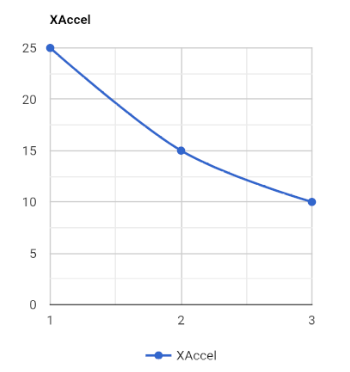Great. You gave me an idea . When I removed the quotes shown in post #5 ,
and use this similar version
the xaxis data still doesn't plot in the WebView. Perhaps Tim has some ideas?
Great. You gave me an idea . When I removed the quotes shown in post #5 ,
and use this similar version
the xaxis data still doesn't plot in the WebView. Perhaps Tim has some ideas?
i did try and error but doesnt seems to find the correct method.anyways thanks alot for helping out,i really appreciate it. well hopefully tim have idea regarding this issue
i did read regarding this chart that produces flickering because it keep refreshing for every new plotted data(for continuous data) but did not encounter any showing up issue so im just guessing that maybe there is incomplete code-block that should be in there
This is about data types. The line chart is expecting a string, and getting a number. If your data generator creates the number as a string with quotes, e.g. ["1",-0.164],["2",-0.1779].... then it will plot. I may have a look at reverting to the ChartMaker style of data entry which allows for setting of types for an update to the extension.
@putera_melaka you will get flickering if you try to refresh the graph with new data, I also found that trying to feed new data to the graph with the webviewstring doesn't work well. Better to generate a chart using the canvas if you want to update data in real time.
I have to correct myself having just done some testing:
will plot this:

You do need the headers to be in quotes.....
[["Direction", "XAccel"], [1, 25], [2, 15], [3, 10]]
Thanks for the updates.
Tried both with ([post #5) and without (post #9) quotes; neither works. I will keep experimenting.
@SteveJG Seems you have a string and not a list (you have quotes around your brackets)
do it result: "[["Direction","X-Accel"],[1,0.25],[2,0.37]...]"
should be
do it result: [["Direction","X-Accel"],[1,0.25],[2,0.37]...]
Oh, I have tried this too
 which certainly is a List.
which certainly is a List. 
Perhaps it does not like the negative values?
 N
N
not negative values as shown above causing the issue.
OK... got it to work ....
I need to clean this up and then will post the solution. 
Cleaned up a bit. Used @putera_melaka aia as a base and modified only the x-acceleration.
Select START ( 1 ) let run a few seconds inducing acceleration change, select STOP ( 2 ), then Show Graph. This is not real time. Uses a Clock to smooth the acceleration data sampling once a second and displays points collected on the xAccelList between steps 1 and 2. You could save the List in a TinyDB.
Can the technique be used used to draw the graph in real time? Experiment and find out.
GRAPHtest2.aia (14.9 KB)
i did test it (start-end-show graph) but most of the time the result as below:
app inventor:
ai companion:
i will install and try it more
A different chart call is required for this, not one from the extension
since the main problem as stated in original post has been solved it fair to mark the solution given.thanks to @SteveJG @TIMAI2
however the minor problem thats needed the graph to show acceleration value in real time is not solved and still in experimenting state.
Glad you got it working. The Project works fine using the Companion for me as does building the apk and loading the compiled Project.
i will first try to make for Y and Z axis the proceed to try and make it real-time moving graph.Thanks alot for helping out .
See attached an example of using google charts with real time data.
rtGoogleLineChart.aia (3.1 KB)
Notice that the "clock" is running in the html, not in the app, and ensure that any values passed with the WebViewString are converted to numbers (see where I used parseInt() - there is also a parseFloat() ).
This example uses a changing webviewstring value to run the loop, you need to feed your realtime values into the when webviewstringChanged block. This seems to run OK for a 1000ms interval, i don't recommend going below this, there won't be enough time to turn things around at the google end.
There may be additional "cycle" issues if/when trying to run three graphs at once ?
Here is a very different way to plot x,y,z using a Canvas in real time.
One developer developed a ‘seismograph’ using AI2 and the Accelerometer. He plots smooth x,y and z curves simultaneously. The example might be something you could do to plot your data… see Seismic …Look at the aia on the 6/25/14 post . What this developer does might suit your purposes but be aware he has a simplified approach to smoothing. See the discussions of possible ways to filter the accelerator data stream discussed here> Filter the errors of accelerometer readings from smartphone using mit app inventor .
alright i will into that ,it comes with sample project, thanks alot
thanks alot, i will look at it,,still learning and considering between webviewer and canvas ,
A couple more projects for you to test:
rtGoogle3LineChart.aia (3.6 KB)
(runs three lines of real time data on single chart using random numbers)
rtGoogle3LineChartAccel.aia (3.4 KB)
(runs three lines of real time accelerometer data from device)